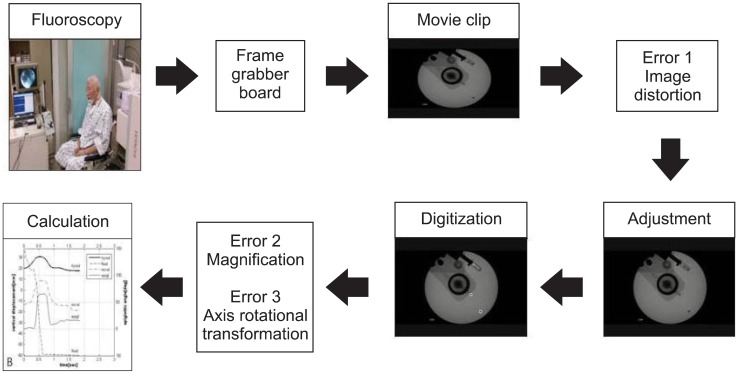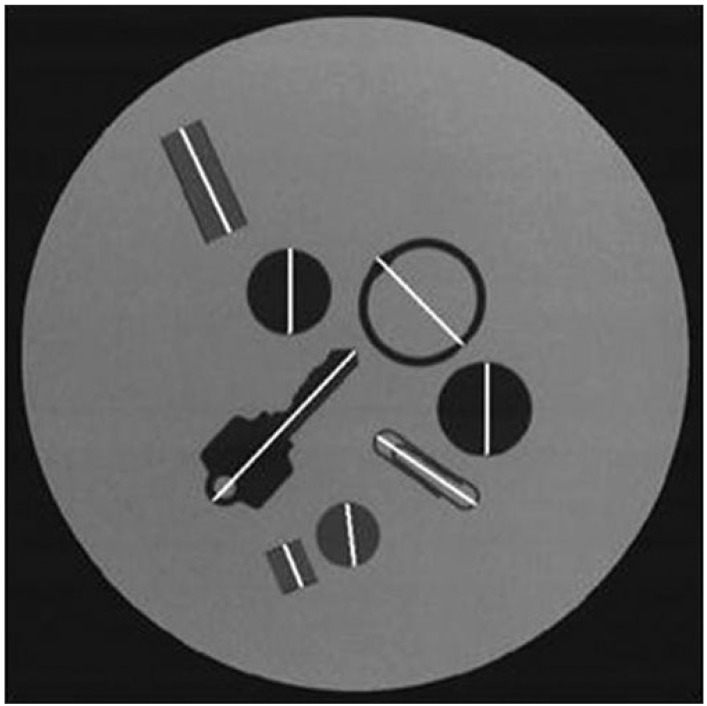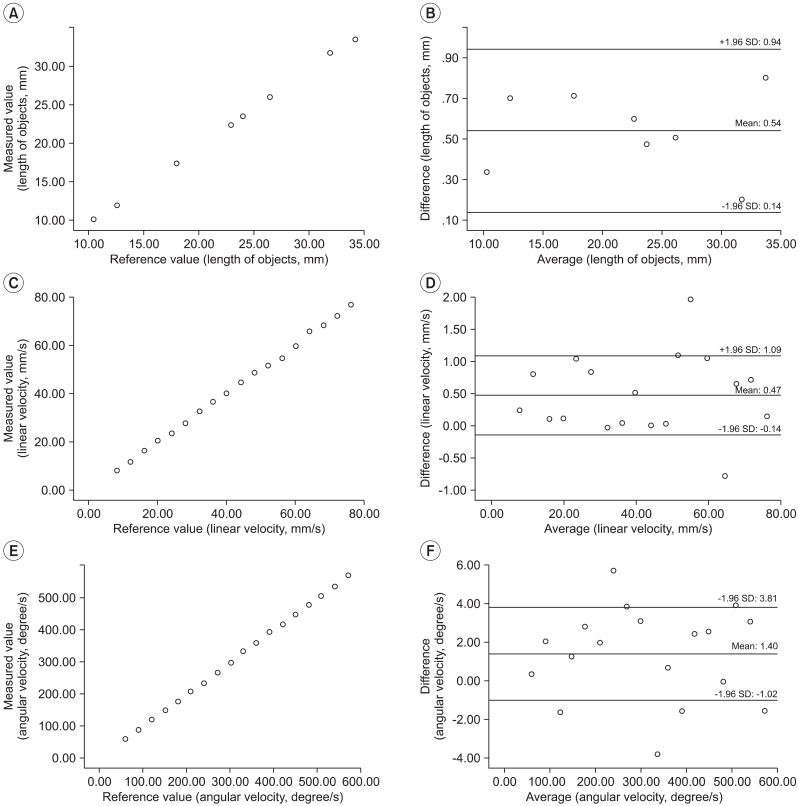Ann Rehabil Med.
2013 Jun;37(3):320-327. 10.5535/arm.2013.37.3.320.
The Accuracy of the Swallowing Kinematic Analysis at Various Movement Velocities of the Hyoid and Epiglottis
- Affiliations
-
- 1Department of Rehabilitation Medicine, Seoul National University Hospital, Seoul National University College of Medicine, Seoul, Korea. keepwiz@gmail.com
- 2Department of Biomedical Engineering, Seoul National University Hospital, Seoul National University College of Medicine, Seoul, Korea.
- 3Department of Radiology, Seoul National University Hospital, Seoul National University College of Medicine, Seoul, Korea.
- KMID: 2219528
- DOI: http://doi.org/10.5535/arm.2013.37.3.320
Abstract
OBJECTIVE
To evaluate the accuracy of the swallowing kinematic analysis.
METHODS
To evaluate the accuracy at various velocities of movement, we developed an instrumental model of linear and rotational movement, representing the physiologic movement of the hyoid and epiglottis, respectively. A still image of 8 objects was also used for measuring the length of the objects as a basic screening, and 18 movie files of the instrumental model, taken from videofluoroscopy with different velocities. The images and movie files were digitized and analyzed by an experienced examiner, who was blinded to the study.
RESULTS
The Pearson correlation coefficients between the measured and instrumental reference values were over 0.99 (p<0.001) for all of the analyses. Bland-Altman plots showed narrow ranges of the 95% confidence interval of agreement between the measured and reference values as follows: 0.14 to 0.94 mm for distances in a still image, -0.14 to 1.09 mm/s for linear velocities, and -1.02 to 3.81 degree/s for angular velocities.
CONCLUSION
Our findings demonstrate that the distance and velocity measurements obtained by swallowing kinematic analysis are highly valid in a wide range of movement velocity.
MeSH Terms
Figure
Reference
-
1. Logemann JA. Evaluation and treatment of swallowing disorders. 2nd ed. Austin: Pro-Ed;1998.2. Splaingard ML, Hutchins B, Sulton LD, Chaudhuri G. Aspiration in rehabilitation patients: videofluoroscopy vs bedside clinical assessment. Arch Phys Med Rehabil. 1988; 69:637–640. PMID: 3408337.3. Logemann JA, Kahrilas PJ, Begelman J, Dodds WJ, Pauloski BR. Interactive computer program for biomechanical analysis of videoradiographic studies of swallowing. AJR Am J Roentgenol. 1989; 153:277–280. PMID: 2750613.
Article4. Wang TG, Chang YC, Chen WS, Lin PH, Hsiao TY. Reduction in hyoid bone forward movement in irradiated nasopharyngeal carcinoma patients with dysphagia. Arch Phys Med Rehabil. 2010; 91:926–931. PMID: 20510985.
Article5. Dyer JC, Leslie P, Drinnan MJ. Objective computer-based assessment of valleculae residue: is it useful? Dysphagia. 2008; 23:7–15. PMID: 17593433.6. Hind JA, Nicosia MA, Roecker EB, Carnes ML, Robbins J. Comparison of effortful and noneffortful swallows in healthy middle-aged and older adults. Arch Phys Med Rehabil. 2001; 82:1661–1665. PMID: 11733879.
Article7. Kim SJ, Han TR, Kwon TK. Kinematic analysis of hyolaryngeal complex movement in patients with dysphagia development after pneumonectomy. Thorac Cardiovasc Surg. 2010; 58:108–112. PMID: 20333574.
Article8. Paik NJ, Kim SJ, Lee HJ, Jeon JY, Lim JY, Han TR. Movement of the hyoid bone and the epiglottis during swallowing in patients with dysphagia from different etiologies. J Electromyogr Kinesiol. 2008; 18:329–335. PMID: 17187991.
Article9. Potratz JR, Dengel G, Robbins J. A comparison of swallowing in three subjects using an interactive image processing system. In : 5th Annual IEEE Symposium on Computer-Based Medical Systems; 1992 Jun 14-17; Durham, NC. Washington: IEEE Computer Society Press;1992.10. Kang BS, Oh BM, Kim IS, Chung SG, Kim SJ, Han TR. Influence of aging on movement of the hyoid bone and epiglottis during normal swallowing: a motion analysis. Gerontology. 2010; 56:474–482. PMID: 20068282.
Article11. Easterling C. Does an exercise aimed at improving swallow function have an effect on vocal function in the healthy elderly? Dysphagia. 2008; 23:317–326. PMID: 18437461.
Article12. Kim Y, McCullough GH. Maximum hyoid displacement in normal swallowing. Dysphagia. 2008; 23:274–279. PMID: 17962998.
Article13. Terk AR, Leder SB, Burrell MI. Hyoid bone and laryngeal movement dependent upon presence of a tracheotomy tube. Dysphagia. 2007; 22:89–93. PMID: 17287926.
Article14. Kendall KA, Leonard RJ. Hyoid movement during swallowing in older patients with dysphagia. Arch Otolaryngol Head Neck Surg. 2001; 127:1224–1229. PMID: 11587603.
Article15. Kendall K, Mckenzie S, Leonard R. Dynamic swallow study: objective measures and normative data. In : Leonard R, Kendall K, editors. Dysphagia assessment and treatment planning: a team approach. 2nd ed. San Diego: Singular Publishing Group Inc;1997. p. 101–125.16. Stoeckli SJ, Huisman TA, Seifert B, Martin-Harris BJ. Interrater reliability of videofluoroscopic swallow evaluation. Dysphagia. 2003; 18:53–57. PMID: 12497197.
Article17. Bingjie L, Tong Z, Xinting S, Jianmin X, Guijun J. Quantitative videofluoroscopic analysis of penetration-aspiration in post-stroke patients. Neurol India. 2010; 58:42–47. PMID: 20228462.
Article18. Ishida R, Palmer JB, Hiiemae KM. Hyoid motion during swallowing: factors affecting forward and upward displacement. Dysphagia. 2002; 17:262–272. PMID: 12355141.
Article19. Nakane A, Tohara H, Ouchi Y, Goto S, Uematsu H. Videofluoroscopic kinesiologic analysis of swallowing: defining a standard plane. J Med Dent Sci. 2006; 53:7–15. PMID: 16722140.20. Palmer JB, Drennan JC, Baba M. Evaluation and treatment of swallowing impairments. Am Fam Physician. 2000; 61:2453–2462. PMID: 10794585.21. Seo HG, Oh BM, Han TR. Longitudinal changes of the swallowing process in subacute stroke patients with aspiration. Dysphagia. 2011; 26:41–48. PMID: 20058029.
Article
- Full Text Links
- Actions
-
Cited
- CITED
-
- Close
- Share
- Similar articles
-
- Influence of Supraglottic Swallow on Swallowing Kinematics: Comparison between the Young and the Elderly
- Kinematic Changes in Swallowing After Surgical Removal of Anterior Cervical Osteophyte Causing Dysphagia: A Case Series
- Comparison of the Hyoid Movement during the Pharyngolaryngeal Swallowing at the Healthy Young and Old Person
- Digital Image Motion Analysis of the Pharyngeal Movement during Swallowing in Dysphagia Patients
- Effect of Decannulation on Pharyngeal and Laryngeal Movement in Post-Stroke Tracheostomized Patients





